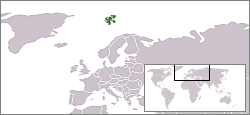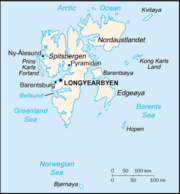Svalbard
|
|
Svalbard, part of the Kingdom of Norway, lies in the Arctic Ocean north of mainland Europe. It consists of a group of islands ranging from 74° to 81° North, and 10° to 34° East; it forms the northernmost part of Norway. Three islands are populated, Spitsbergen, Bjørnøya and Hopen.
| ||||
| Motto: None | ||||

| ||||
| Official language | Norwegian | |||
| Capital | Longyearbyen | |||
| King | Harald V | |||
| Governor | Odd Olsen Ingerø | |||
| Area - Total | Ranked 122nd 62,049 km² | |||
| Population - Total (2004) - Density | Ranked 230th 2,756 0.04/km² | |||
| Currency | Norwegian krone | |||
| Time zone - in summer | CET (UTC+1) CEST (UTC+2) | |||
| National anthem | Ja, vi elsker dette landet | |||
| Internet TLD | .no (.sj allocated but not used (http://www.norid.no/domenenavnbaser/bv-sj.html)) | |||
| Calling Code | 47 | |||
| Contents |
History
Main article: History of Svalbard
Vikings and/or Russians may have discovered Svalbard as early as the 12th century. Traditional Norse accounts exist of a land known as Svalbard - literally "cold edge". But the Dutchman Willem Barents made the first indisputable discovery of Svalbard in 1596. The islands served as an international whaling base in the 17th and 18th centuries. They also provided the headquarters for many Arctic exploration expeditions. Comprehensive geological mapping of the archipelago was conducted by teams from Cambridge and other universities, led primarily by W. Brian Harland from the 1940s to 1980s.
The largest island in the archipelago is called Spitsbergen (Jagged peaks); the name is commonly but inaccurately used to refer to the whole archipelago.
Politics
Main article: Government of Svalbard
By the terms of the Svalbard Treaty of February 9, 1920, international diplomacy recognized Norwegian sovereignty and designated the area as demilitarized. Norway took over administration of Svalbard in 1925. However, under the terms of this unique treaty, citizens of various other countries have rights to exploit mineral deposits and other natural resources "on a footing of absolute equality". As a result, a permanent Russian settlement, more or less autonomous, grew up at Barentsburg. The Russians abandoned another settlement at Pyramiden in 2000. At one time, the Russian (or Soviet) population of Svalbard considerably exceeded the Norwegian population, although this no longer applies.
An appointed Norwegian governor, the sysselmann, based in the town of Longyearbyen, administers the territory. The callsign for each amateur radio station starts with JW.
Geography
Main article: Geography of Svalbard
Svalbard consists of a group of islands in the Arctic Ocean; ranging from 74° to 81° North, and 10° to 34° East, it forms the northernmost part of Norway and the northernmost lands of Europe. The islands cover an area of 62,050 km². Three large islands dominate: Spitsbergen (39,000 km²), North East Land (14,600 km²) and Edge Island (5,000 km²).
60% of Svalbard is covered by glaciation and snowfields. Indeed, the name 'Svalbard' means 'cold coast'. However, the North Atlantic Current moderates the Arctic climate, keeping the surrounding waters open and navigable most of the year. Svalbard lies north of the Arctic Circle. In Longyearbyen, the midnight sun lasts from April 20 to August 23, and perpetual darkness lasts from October 26 to February 15.
Svalbard also serves as the breeding ground of the barnacle goose and a variety of other birds; best seen from cruise ships. Four mammal species inhabit the archipelago: the Svalbard field mouse Microtus epiroticus, the Arctic fox, the Svalbard reindeer (a distinct sub-species), and polar bears. Since polar bears occur very commonly on Svalbard, all people need to take precautions when outside the settlements: this includes carrying a rifle. Nevertheless, the law protects polar bears, forbidding anyone to harm or disturb them.
There is an astonishing variety of flowering plants on Svalbard. Although they are very small, this plants use the short period of 24 hour daylight to produce colourfull blossoms. See also: Flowers of Svalbard.
Settlements
- Barentsburg (Баренцбург) (Russian settlement -- population of 900)
- Bjørnøya
- Grumant (Грумант) (Russian settlement, abandoned in 1961, revival of mining operations announced in 2003)
- Isfjord radio
- Longyearbyen (population of 1,700)
- Ny-Ålesund (population of 40)
- Pyramiden (Пирамида) (Russian settlement, abandoned in 2000)
- Smeerenburg (Dutch settlement, abandoned around 1660)
- Sveagruva (population of 210)
No roads link the settlements on the island; transportation mechanisms include boat, plane, helicopter, and snowmobile.
Economy
Main article: Economy of Svalbard
Economic activity centres on coal mining, supplemented by fishing and trapping. In the final decades of the 20th century, tourism, research, higher education, and some high-tech enterprises like satellite relay-stations have grown significantly. Norway claims an exclusive fishing zone of 200 nautical miles; Russia does not recognize this.
The Svalbard Undersea Cable System which started operation in January 2004 provides dual 1,440 km fiber optic lines from Svalbard to Harstad via Andøy, needed for communicating with polar orbiting satellite stations on Svalbard, some owned by NASA and NOAA.
The Norwegian state-owned coal company employs nearly 60% of the Norwegian population on the island, runs many of the local services, and provides most of the local infrastructure.
Demographics
Main article: Demographics of Svalbard
Svalbard has a population of approximately 2,800 people. 60% of the people are Norwegian; 40% are Russian and Ukrainian. The official language of Svalbard is Norwegian, although Russian is used in the Russian settlements.
Culture
Main article: Culture of Svalbard
External links
- Governor of Svalbard (http://www.sysselmannen.svalbard.no/) - Official site
- Template:Wikitravel
- The Svalbard Pages (http://www.svalbard.com/) - Svalbard links and discussion forums for Svalbard
- General information on Svalbard (http://go.to/spitsbergen)
- The Svalbard Project (http://www.svalbardproject.com/english/svalbard.html)
- includes images of Svalbard (http://www.spitsbergen.cjb.net)
- Svalbard - A Polar Experience (http://home.online.no/~okleven/)
- Svalbard, The land with gold coasts (http://www.willassen.no/guide/omraader/svalbard/index.en.html)
- The Svalbardsyk Homepage (http://dpwww.epfl.ch/instituts/ipt/berglund/svalbard.html)
- Svalbard Satellite Station website (http://www.svalsat.com/)
- Svalbard Images - Maps and Pictures (http://www.svalbard-images.com)
- Treaty Concerning the Archipalego of Spitsbergen (http://www.austlii.edu.au/au/other/dfat/treaties/1925/10.html)
- The University Centre in Svalbard (http://www.unis.no)
- The Auroral Station in Adventdalen (http://haldde.unis.no)ast:Svalbard
da:Svalbard de:Svalbard et:Svalbard eo:Svalbardo kaj Jan-Majen-Insulo es:Svalbard fr:Svalbard id:Svalbard it:Svalbard ja:スバールバル諸島 nl:Spitsbergen no:Svalbard nn:Svalbard pl:Svalbard pt:Svalbard ro:Svalbard sk:Svalbard sl:Svalbard fi:Huippuvuoret sv:Svalbard


